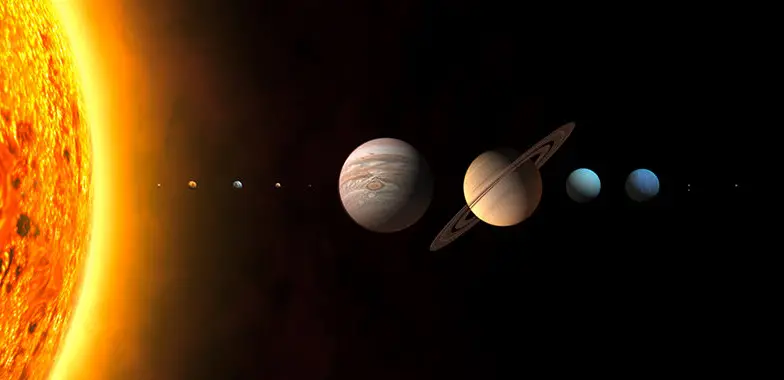For the first time in a decade, all the planets will be visible in November. Some of them will be visible to the naked eye, and for the rest you will need binoculars.
Mercury
Mercury is the closest planet to the Sun. Mercury is the second smallest planet by size. The planet Mercury is visible to the naked eye. We can observe it twenty days a year, either immediately after sunset or before sunrise. Mercury was also known to the ancient peoples. The ancient Greeks had two names for this planet: when it appeared as a morning star it was known as Apollo, and in the evening it was called Hermes. Today’s name was later given to it by the Romans. Mercury, according to their mythology, was the god of trade, travel, theft.
Mercury will be seen in the morning in early November from the northern hemisphere. The biggest morning elongation will reach on November 10.
Venus
Planet Venus is similar in size to Planet Earth. Venus in the night sky appears as the brightest object, right after the Moon. According to Greek mythology, the planet Venus was the goddess Aphrodite – the beautiful goddess of love and beauty, and it gets its name today from the counterpart of Aphrodite in Roman mythology. Compared to most other planets in the Solar System, Venus has an unusual rotation around its axis. Most planets rotate projectively – from west to east, and Venus rotates retrograde – from east to west.
The planet Venus reached its greatest elongation from the sun on August 12, but it will remain bright and visible until the end of the year. When you can see it depends on where you live.
If your location is in the middle-north latitude, at the beginning of November Venus will rise three hours before the sun. With the passing of the month of November, it will decrease to two and a half hours before the sun.
If your location is near the equator Venus will rise two hours before the beginning of November, with the end of November it will rise one hour and fifty minutes before the sun.
If your location is in the southern hemisphere: Venus will rise for about an hour and a half throughout the month.
Mars
Mars is the fourth most distant planet from the Sun. Mars (Greek Ares) is the god of war. The planet probably got its name from its red color, and is sometimes called the red planet. When in the night sky, Mars is easily visible to the naked eye. Its apparent magnitude varies considerably depending on its relative position relative to the Earth.
Mars reached its greatest light during the month of October when it reached the point of opposition in the sky. This means that it is opposite to the sun in our view of the earth.
Jupiter and Saturn
Jupiter is the fifth planet at a distance from the Sun and by far the largest. According to Roman mythology, Jupiter was the king of all the gods, the ruler of Olympus (a counterpart of Zeus in Greek) and the patron saint of the entire Roman Empire. Zeus was the son of Chronus (Saturn). In the sky, Jupiter appears as the fourth brightest object in the sky (after the Sun, Moon and Venus; sometimes Mars is also brighter).
Saturn is the sixth planet at a distance of from the Sun, orbits about 10 astronomical units of the Sun and is the second largest. In Roman mythology, Saturn is the god of agriculture.
The visibility of Jupiter and Saturn will be possible immediately after sunset during the month of November, until the end of the year. In December, the two planets will experience the Great Conjunction. This means that the two planets will experience a meeting. This is a phenomenon that happens once in twenty years. Jupiter will be seen brighter than Saturn, so it will be easier to locate Saturn.
Uranus and Neptune
Uranus is the seventh planet at a distance from the Sun and the third largest. The strangeness of Uranus is that it is turned to the “side”, ie. its axis of rotation is tilted by as much as 98 degrees relative to the ecliptic.
Neptune (Greek Poseidon) is the god of the sea in Roman mythology. It is the eighth planet at a distance from the Sun. This blue planet reflects about 41% of its solar energy. With a powerful telescope from Earth it can be recognized as a blue disk.
These two planets will be visible during the month of November, and to see them you will need binoculars and a good telescope.

